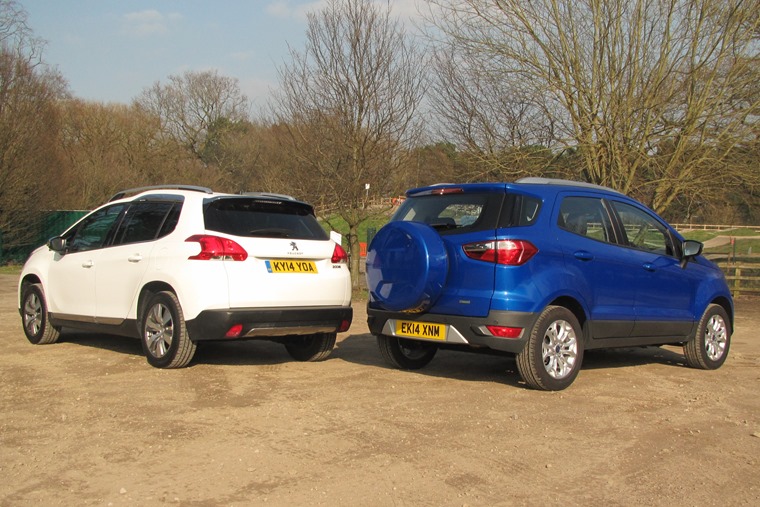Ford EcoSport vs Peugeot 2008 – battle of the jacked-up superminis
The UK is a nation of supermini lovers - that should come as no revelation, we’ve said it before - but British motorists have pined for something more in recent years.
Hence the influx of B-segment crossovers offering the elevated ride height and rugged looks of an SUV but retaining the running costs of their compact runaround.
Ford’s EcoSport and Peugeot’s 2008 are two relatively late additions to the jacked-up supermini crowd and just like a malevolent schoolteacher, we’ve brought them to the front of the class to see if they contribute anything worthy of leading the class.

Exterior
James Fossdyke says: It’s a real struggle to decide, which car is uglier? Certainly, neither looks as good as the hatchback it’s based on. The EcoSport is too bulky, and rather than looking like a muscular Fiesta, it just looks a bit fat.
The 2008, meanwhile, has gone the other way, appearing more dorky than the 208 despite the body cladding. I think the problem is that its features all appear too small for its body.
It’s a tough choice then, but push is turning to shove so I’m going to come down in favour of the Ford. It’s just a taste thing – the Ford is simply further up my street.
John Simpson says: At first glance, you’d swear the EcoSport bore an unfair size advantage over the 2008 but it’s only upon crunching the numbers that you realise how close the two are, size-wise.
The Ford may be almost 11cm taller and 2.6cm wider but the 2008 is 14.8cm longer. Even placing the two side-by-side, you can almost see the hulking EcoSport tittering as it belittles the puny Peugeot. It shouldn’t be so cocky - size isn’t everything and the 2008’s strengths lie in other areas – but on an aesthetic level, the EcoSport has buckets more personality for me.
Look at the Ford’s vast gaping chrome grille, like a whale hoovering up helpless krill, then compare it to the Peugeot’s tame front end; it’s not ugly like Foss suggests but it’s a non-event in comparison.
I’m a big fan of EcoSport’s rear mounted spare wheel too, which has been so divisive that Ford recently made it a non-cost extra. I understand the benefits to aerodynamics and fuel economy but the Toyota RAV4 always looked better with its tyre backpack and it’s the same story here. The kid stays in the picture.
Search Ecosport leasing deals: business / personal
Search 2008 leasing deals: business / personal
Interior
James says: Both cars have pinched interiors from their supermini siblings, so this is a case of 208 v Fiesta as much as 2008 v EcoSport.
The Ford and Peugeot both suffer from the usual problems blighting small, cheap cars – namely iffy cabin plastics and tacky switchgear, but both also feel roomier than their low-riding siblings.
The Peugeot’s the more spacious of the two though, with a huge boot and a similar amount of rear passenger space.
It’s classier too, with better-looking plastics, even if they feel a bit tinny. I’m not a fan of the pebble-shaped handbrake, the ‘Bronze’ trim or the mediocre touchscreen, but all in all, it’s a better place to spend time than the EcoSport, which is let down by a scratchy dash and low-tech infotainment screen.
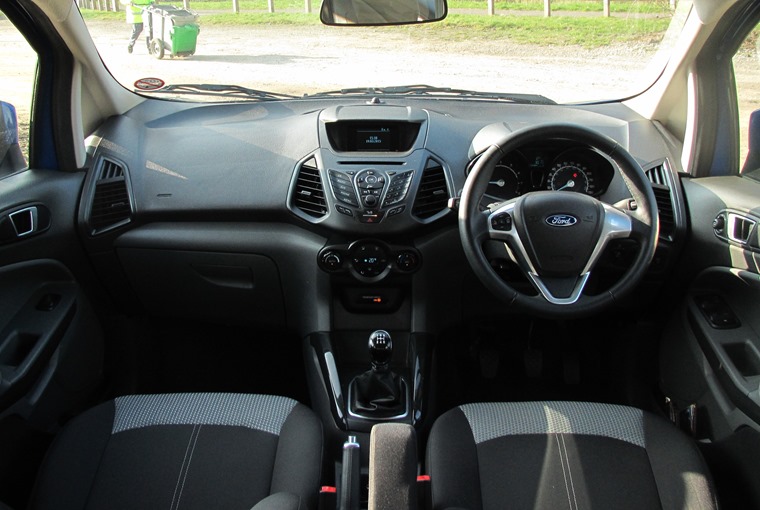
John says: The Peugeot may be unremarkable on the outside but it claws back some ground inside. In terms of cabin quality and design, it is way ahead of the Ford which looks and feels drab and tired. Anyone initially excited by its exterior is likely to feel deflated when they look inside.
Ford may contest that it’s a familiar layout that has worked in the Fiesta but here it doesn’t click and leaves it lagging behind the segment standard. Notable culprits include the steering wheel’s cheap leather and the dull grey plastic surfaces.
Observant readers will note there are grey plastics in the 2008 too but there’s a much wider palate utilised with various textures and gloss black in the centre console to break things up.
Some of the leftfield touches like the dinky steering wheel – nicked from the 208 and 308 – and the pebble handbrake won’t be to everyone’s tastes but at least they show that the Peugeot is making an effort to be different. For me, it works, I love these kooky features.
There is one caveat though. This was the last Peugeot to feature this specific seven-inch touchscreen, you’ll find the same system in the 208 and it’s frustratingly clunky. Everything from setting a destination point to choosing a radio channel is needlessly tedious due to its sluggish response and awkward menus.
Not the case with the EcoSport, in fact you won’t find any touchscreen of any form in any EcoSport. Instead, Ford has kept it simple. It has reined in the button-busy dashboard of old but there’s still an alphanumeric pad, y’know because nobody keeps their numbers stored on their phone… Further evidence of Ford not really trying.
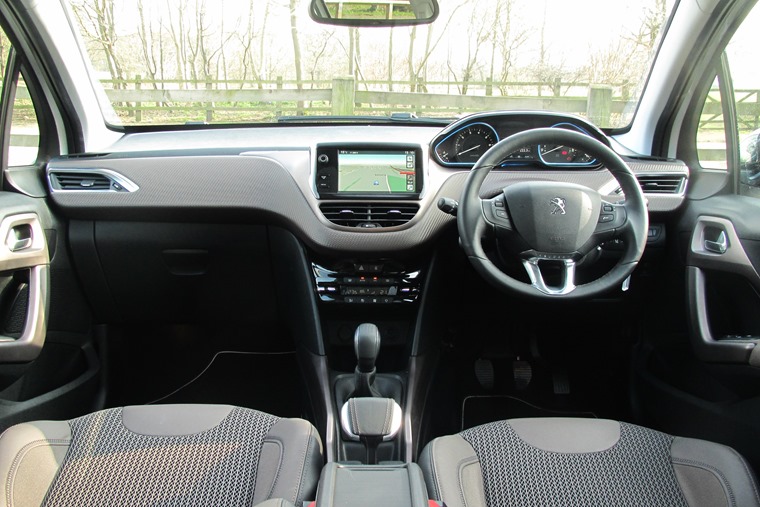
On the road
James says: Both our cars came with piddling petrol engines, but despite having less displacement, the EcoBoost engine in the EcoSport had more power.
A whole 128bhp made the 1L EcoSport about a second faster to 62mph, but if truth be told, it felt even more potent than that.
With just 81bhp, we knew the 1.2L 2008 would be slow, but we weren’t prepared for the noise. The lack of soundproofing in the bulkhead and wings seemed to be the main culprit, but the three-pot engine was decidedly rumbly.
The 2008’s lower ride height and enormous boot makes it feel more like an estate version of the 208 than a proper crossover, but that’s no bad thing when it comes to handling. It’s chuckable and comfortable, and though the engine is pretty naff, it’s a decent enough drive.
In contrast, the Ford feels more like a Fiesta compromised by tall springs. The ingredients for a sporty drive are all there but it has been blunted by the ride height. It’s more refined than the Pug though.
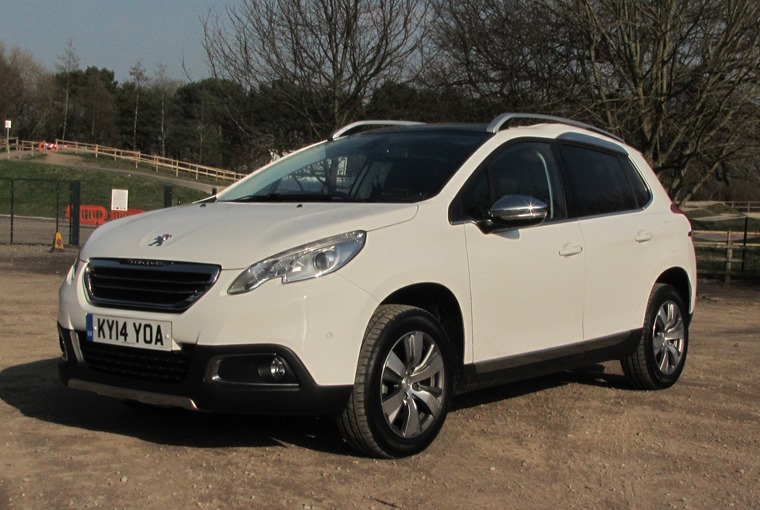
John says: For pottering about, the 2008 feels the sharper of the two with the bulk of its power coming in the lower rev register. The EcoSport reserves most of its shove high up and only shows its true power when you get above 3,000rpm.
 The 2008’s go-kart like steering wheel compliments its sharper, grippier handling and delivers the more enjoyable drive by far. Sadly, it’s let down by the wobbly five speed manual resulting in some dubious gear changes, especially slotting into fifth which can often prove finicky.
The 2008’s go-kart like steering wheel compliments its sharper, grippier handling and delivers the more enjoyable drive by far. Sadly, it’s let down by the wobbly five speed manual resulting in some dubious gear changes, especially slotting into fifth which can often prove finicky.
Further flaws are revealed on the motorway with road and wind noise flooding into the 2008’s cabin. You don’t need to be pushing the speed limit, even at a very sensible 55mph, you’ll find yourself raising your voice to be heard.
The EcoSport rides the motorways with more composure with a calmer, quieter ride and more surefooted gearbox. It’s hardly S-Class rivalling but for a cross-Pennine jaunt from Manchester to Leeds, the EcoSport was definitely the smart choice.
Sticking the passenger seatbelt buckle right up against the handbrake means you’ll risk shaving off several layers of skin from the back of your hand. Grizzly.
The Ford’s boot is slightly smaller - 333 litres to the 2008’s 360 - and its taller narrower packaging makes it more awkward to cram in a decent weekly shop and as a result, a bumper box of nappies was left on the shelves…

Running costs
Since the arrival of the 308 SW, Peugeot has hastily tacked the Puretech label (Pug’s equivalent of Ecoboost) onto all its petrol engines but don’t be fooled, this is the same VTi engine from launch and the association is strictly literary.
That said, both engines here are reasonably efficient and economical but the Peugeot is more so.
It claims a 57.6mpg combined at 114g/km CO2 (VED Band C - £30) and weighing not much more than a ton (1045kg) certainly works in its favour.
That’s 305kg less than the EcoSport, but fuel return isn’t far behind the Pug’s (53.3mpg). A higher CO2 output means road tax creeps in the next band (D - £110). The Ford’s £16,445 list price is almost £1,000 more than the Peugeot, which has a stronger spec list with a panoramic sunroof and touchscreen sat nav (which I’d take, even with its flaws).
Who buys outright though eh? We’re leasing here and for business users, the Ecosport is cheaper at £143.01 compared to £154.82. Going personal stretches the gap even further with the most affordable EcoSport Titanium 1L Ecoboost costing £171.61 a month to the 2008’s £190.10 (24 month, 10k miles p/a).
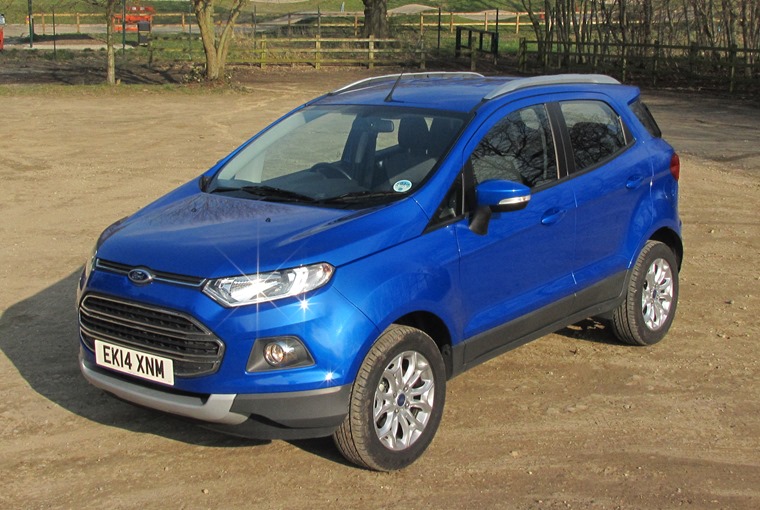
Verdict
James says: It’s very close between these two, but if I’m honest I think it’s a case of ‘which do I dislike least?’
I think the Peugeot would probably win through if it was a matter of head over heart – not least because of its price tag – but I have to put my neck out and say I think I’d rather have the EcoSport, simply because it’s more to my taste.
John says: I’ll admit, the prospect of driving the EcoSport was far from enticing but I warmed to it the more miles I covered with it.
The tired interior isn’t to my taste and its lumpy steering means it’s not nearly as fun to chuck about but it is the preferred choice for longer journeys and the 1L engine does a great job at shifting a car this size.
As a product, I’d choose the 2008 on the grounds that it’s more fun to live with but the Ford’s leasing rates are far more attractive.
| Ford EcoSport 1.0 125PS Ecoboost Titanium | Peugeot 2008 1.2 VTi 82PS Allure | |
| Length | 4011mm | 4159mm |
| Width | 1765mm | 1739mm |
| Height | 1665mm | 1556mm |
| Wheelbase | 2519mm | 2538mm |
| Boot space | 333 / 1238 litres | 360 / 1194 litres |
| Combined fuel consumption | 53.3mpg | 57.6mpg |
| CO2 emissions | 125g/km | 114g/km |
| VED band | D - £110 | C - £30 |
| 0-62mph | 12.7 seconds | 13.5 seconds |
| Top speed | 112mph | 105mph |
| Kerb weight | 1350kg | 1045kg |
| OTR price | £16,445 | £15,595 |

